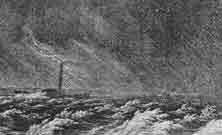Before the
Legend of Noah
|
|

This tablet was an economic text
From H.V. Hilprecht Vol I: THE BABYLONIAN EXPEDITION 1904 |
ACCORDING TO AN INSCRIBED CLAY TABLET DISCOVERED IN NIPPUR, IRAQ BY AN AMERICAN EXPEDITION 1883 - 1886; A MAN AND HIS FAMILY SURVIVED A CATASTROPHIC FLOOD BY RECEIVING ADVANCED WARNING FROM GOD, PROBABLY BEFORE 1800 BC. Arno Poeble, a University of Pennsylvania professor of ancient Middle Eastern languages, was reading clay tablets catalogued in 1904 from the third UPA expedition to Nippur. He found a tablet containing the story of a man rescued from a flood. Arno Poeble published the translation of this tablet in 1914. The tablet was written in Sumerian, a language that was disappearing from common conversation by 1800 BC, but continued to be used by scribes in their copying of early manuscripts for hundreds of years. In the story there was a man named Ziasudra. The tablet was in bad condition and numerous parts were missing. It began as one of the gods of the Sumerian assembly of gods told Ziasudra to stand closer to the wall. In those days families lived in reed huts along the rivers and canals such as those depicted later in this work. As Ziasudra was allowed to sense communication similar to one eavesdropping through a reed wall he was told that by the hand of the gods one would "bring about a rainstorm to destroy the seed of mankind." The tablet was in bad condition and resumed with the passage: "All the windstorms which possess immense power, they all (and) together came, forth (again) ... The rainstorm.... raged with them. When for seven days, and seven nights, the rainstorm had raged in the land; the huge boat on the great waters had been carried away by the windstorms. Samas (sun god) came forth, shedding light over Heaven and Earth. Ziasudra opened a ...(window)...of the huge boat. The light of the hero Samas he let enter into the (interior) of the boat." [This translation was from Arno Poeble's Historical Texts (1914) paraphrased. Ziasudra was further described as offering an ox and a sheep as a sacrifice to the god. The chief gods Anu and Enlil were written as granting eternal life to Ziasudra. Another tablet recovered from Sippar was written by Ku-Aya a scribe of Ammisaduqa (c. 1700 BC) the grandson of King Hammarubi of Babylonia. From a publication of Albert T. Clay: A Hebrew Deluge Story in Cuneiform...and other fragments in the Pierpont Morgan Library (Yale Oriental Series - Researches Volume 3 1922). From a 1700 BC clay tablet it seems a god or gods were angry because mankind had become too numerous and their noise was too loud. As if the gods sending drought, malaria, and famine was not enough; there was a myth of their plan to send a flood. The tablet was broken, yet a few words exist to describe an imminent flood as a judgment and thus the tablet was identified as an early variation of the flood story. A fragment of an Assyrian version of the legend indicated that Atrahasis was told to build a boat and to make it strong above and below ... at the appointed time ... (gather) in it your grain, your possessions, and your property. Your (wife), your family, the animals of the field ... the ones that eat the grass (livestock). Atrahasis replied to his god Ea that he had not yet built a ship. Atrahasis received a command to draw a plan on the ground, Atrahasis responded, "Show me the plan and I will build the ship." Atrahasis drew on the ground ... what was commanded. (This Atrahasis tablet was also listed in the Yale Oriental Series - Researches Volume 3 cited above) Further information
might be found by using a search engine to research the |
|
|
|
|
|
|
